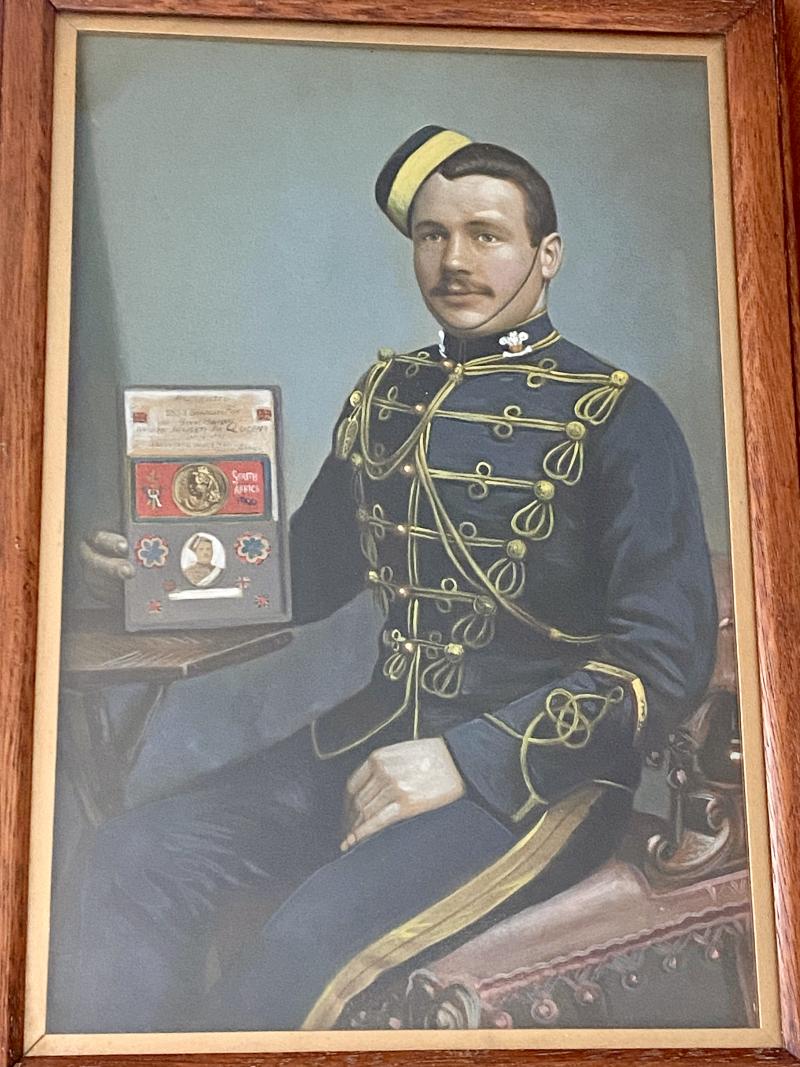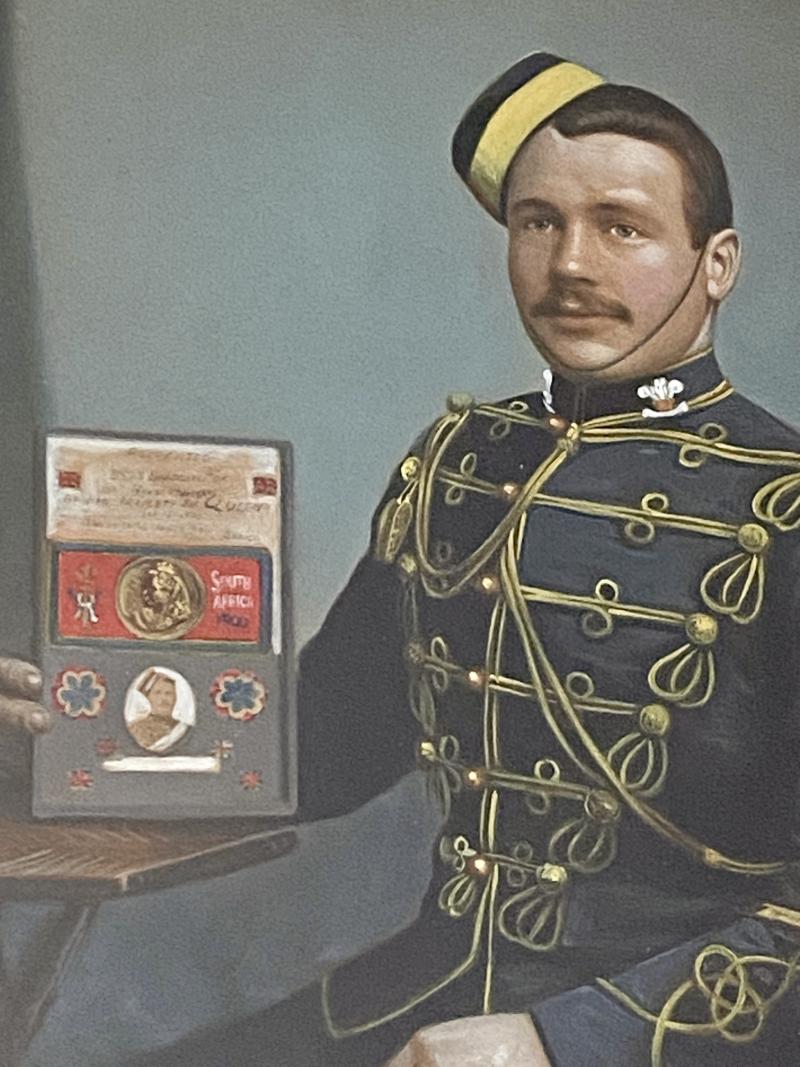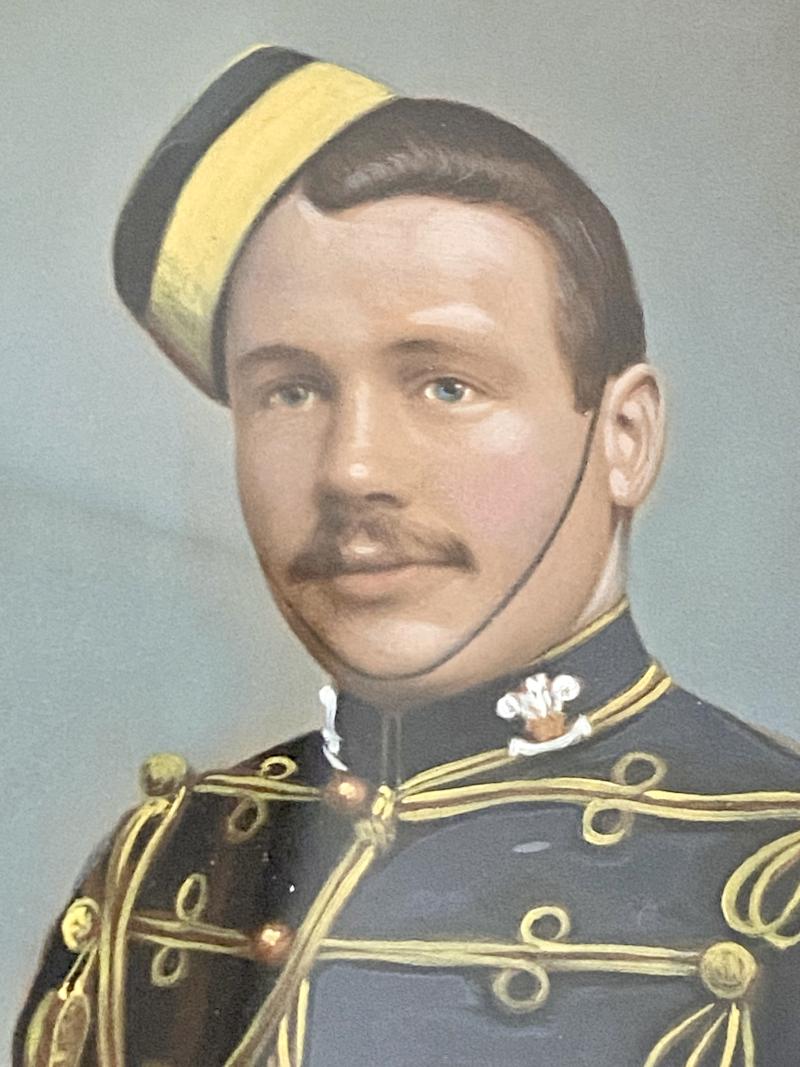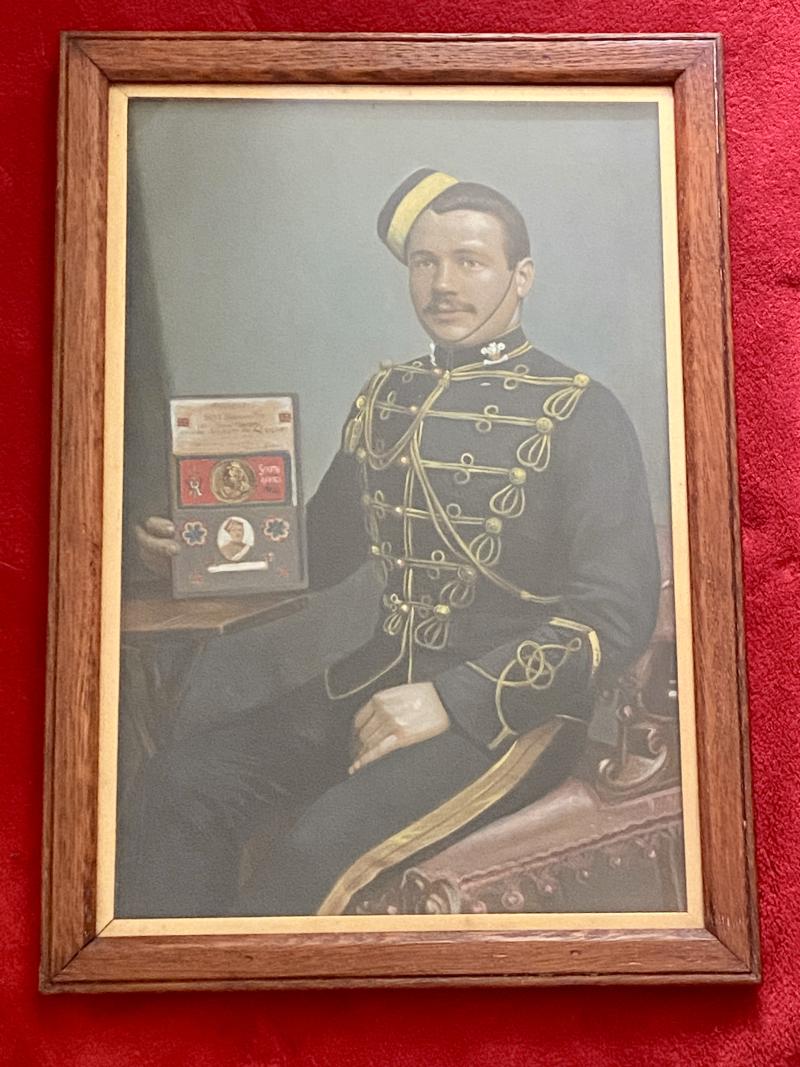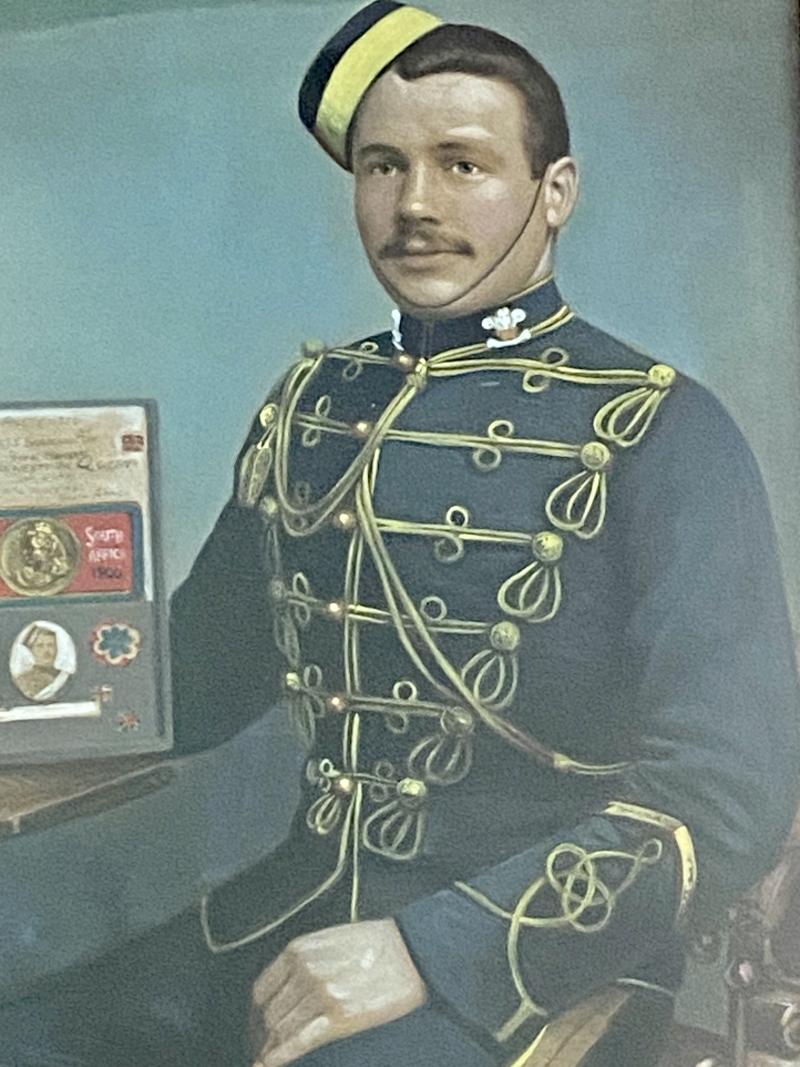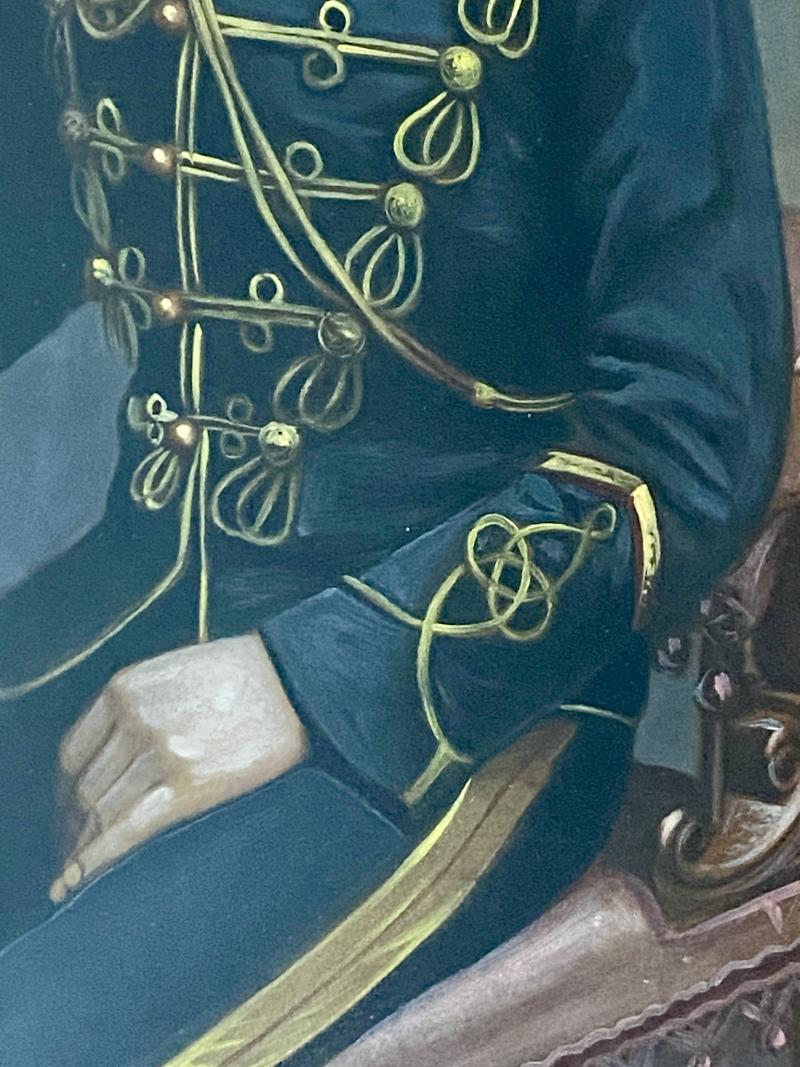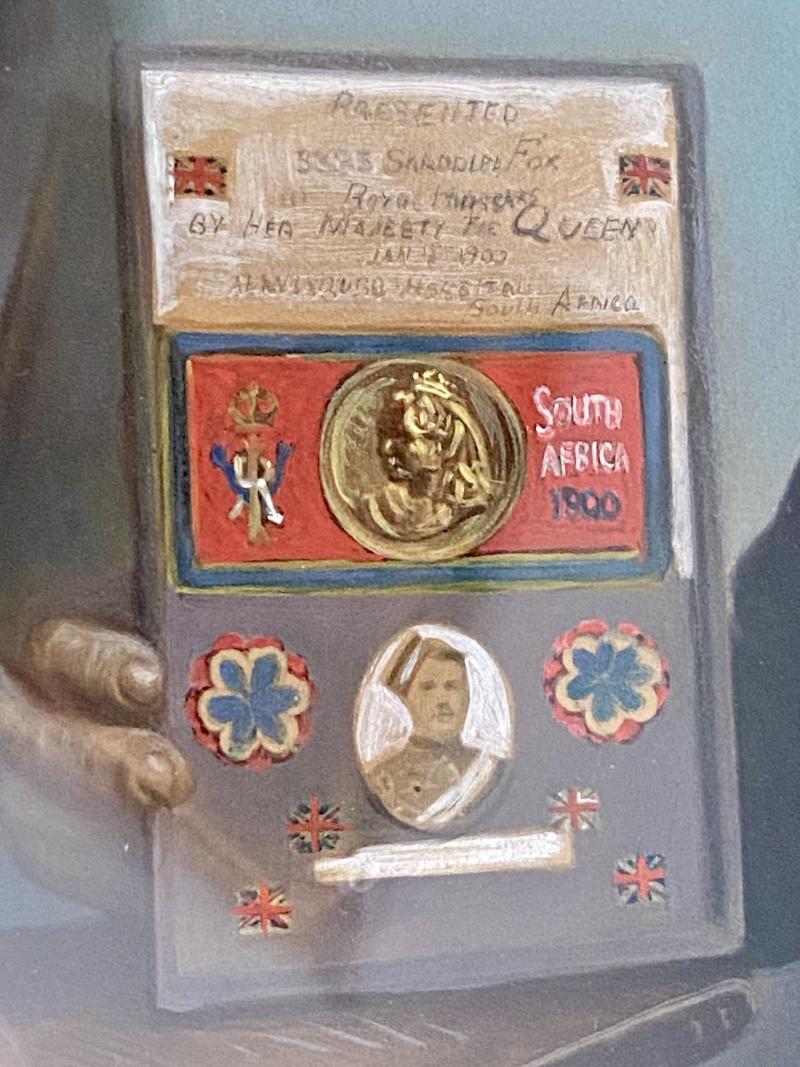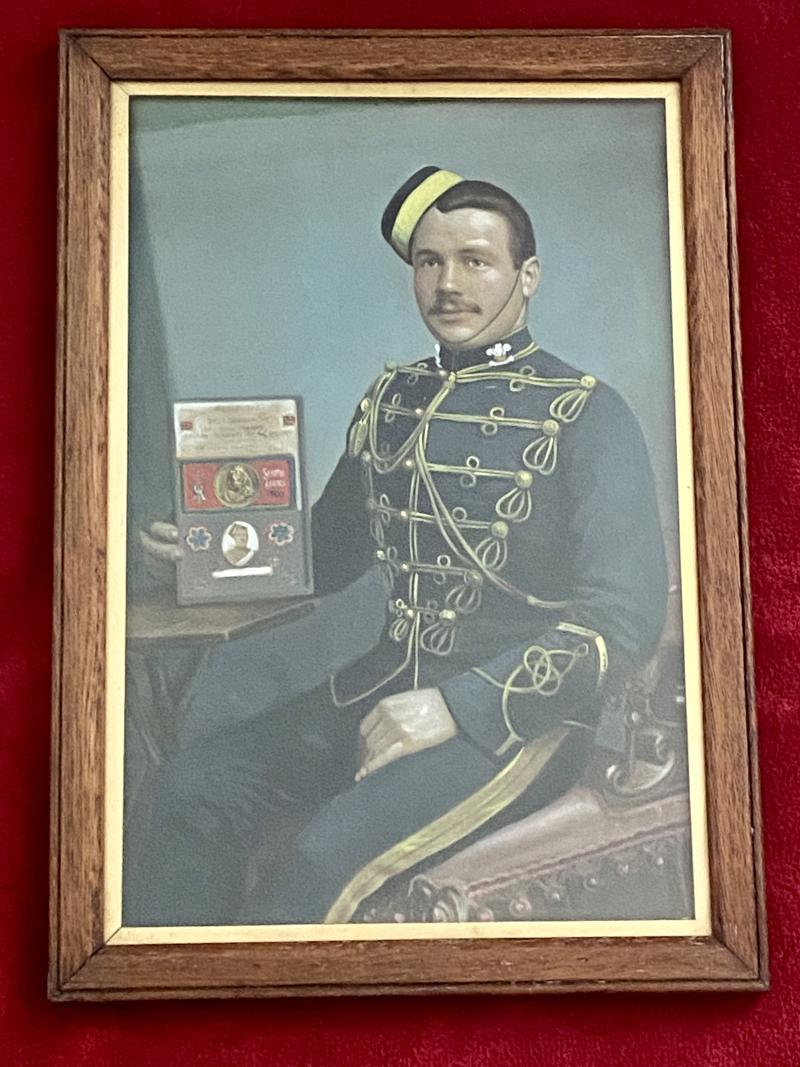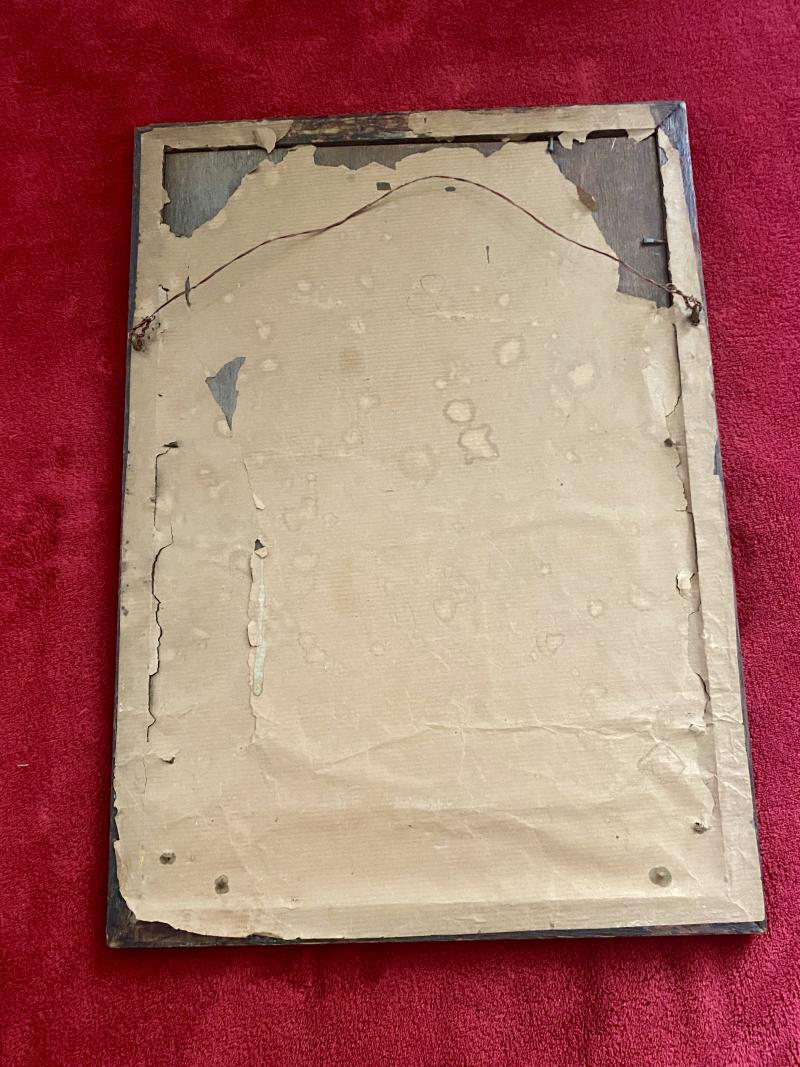Original Framed Portrait of Named Boer War British Soldier – J.FOX - Saddler – 3383 of the 10th (Prince Of Wales Own Royal) Hussars
Here on offer is a fine original oil painting of a named Boer War British Soldier sitting in a Victorian chair, in his uniform of the 10th (Prince Of Wales Own Royal) Hussars.
His name is J.FOX, rank Saddler, with a service number 3383.
He was awarded both The Queen's South Africa (QSA) Medal and clasps: Cape Colony, Transvaal, and the King's South Africa (QSA) Medal and clasps: South Africa 1901, South Africa 1902
He is proudly holding a display with his Queen Victoria tin and his details are actually painted onto the display box of the tin, that he is resting on the table.
The details in the painting read as:
PRESENTED
3383 SADDLER FOX
10th ROYAL HUSSARS
BY HER MAJESTY QUEEN VICTORIA.
JAN 18 1900
AT WINBURG HOSPITAL
SOUTH AFRICA
It says presented by Queen Victoria but as she didn't ever go to South Africa, these tins where issued to soldiers on behalf of Queen Victoria.
Below the tin it has a small photo of Fox painted within it and union jack flags and some other decoration painted around it.
The painting is in excellent condition and as “fresh” today as when it was painted. It appears to be “oil on board” example with no artists signature that I can see. There may be one which is covered by the frame?
It still has the original oak frame and clear glass panel which was handmade and contains some natural air bubbles.
Below is an extract of his war records that show he was actually wounded on 13th December 1899 at Arundel.
From the details in his painting, was treated at the Winburg hospital, where he must have recovered and served again, as he was awarded both the South Africa 1901 and 1902 medal bars.
Anglo-Boer War records 1899-1902 Transcription
FirstName J
Last Name Fox
Number 3383
Rank Saddler
Regiment 10th (Prince Of Wales's Own Royal) Hussars
Year 1899-1902
Notes The Queen's South Africa (QSA) Medal Clasps: Cape Colony, Transvaal
The King's South Africa (QSA) Medal Clasps: South Africa 1901, South Africa 1902
Rolls Roll: 116, Page: 133
Roll: 304, Page: 104
Units Unit: 10th (Prince Of Wales's Own Royal) Hussars, Rank: Saddler, Number: 3383
Casualties Details: Wounded on 13 December 1899 at Arundel (Official casualty roll location: Arundel)
Unit: 10th (Prince Of Wales's Own Royal) Hussars
Source: South African Field Force. JB Hayward & Sons
Gazetteer: 3024: 3057-2501 a station in the Cape Colony (Colesberg district; Northern Cape) on the railway line from Port Elizabeth through Bloemfontein to Johannesburg. Variants: Arundel Siding (so named to 1912; used in HMG); Arundel Station (so named from 1912; used in the Times); Arundelstasie (Afrikaans spelling). The station was occupied by invading Boer forces on 7 November 1899. Veg-Gen H.J. Schoeman had an outpost here under Field Cornet Coetzer. During Maj-Gen J.D.P. French's advance northwards along the railway line his intention to occupy Arundel on 23 November was frustrated by a party of some 100 burghers posted on a hill to the north of the station. With a strengthened column French pushed north again and on 7 December Col T.C. Porter, 6th Dragoon Guards (Carabiniers), commanding a contingent of mounted infantry, New Zealand Mounted Rifles and New South Wales Lancers, occupied Arundel without serious opposition. Over the next few days Arundel was organised as a standing camp and French moved his headquarters there on 17 December. On 14 February 1900, Maj-Gen R.A.P. Clements (replacing French), threatened by Boer forces commanded by Veg-Gen P.D. de Wet, was forced to retreat to Arundel where he was reinforced. Maj-Gen Lord Kitchener was in Arundel on 25 February. On 27 February, de Wet, knowing of Asst Cmdt-Gen P.A. Cronjé‚'s perilous position at Paardeberg* and with Clements on the offensive, withdrew across the Orange River. HMG I pp.277284 (map no.16), II pp.252-253; Times III, pp122-3 (map facing p.512); Breytenbach I p.456, IV (map facing p.450); Wilson I p.129; Doyle p.359; Goldmann p.41 (first map facing p.68).
The rank of Saddler is charged with the repairs of all harness, horse, and other leather equipment issued to his regiment. He must be skilled in the use of the tools, which comprise the saddlers' set.
Saddlers, like shoeing-smiths, wheelers, fitters and a few other trades were appointments, carrying a higher rate of pay and known collectively as artificers.
In the painting, it says he is a Saddler but he is also shown as a Corporal on some reference web sites.
This is a rare opportunity to acquire a genuine period oil painting depicting a named Boer War soldier, if only you could find his medals!
The picture frame measures 17” (43cm) by 12” (30.5cm) and weighs 1.3Kg.
Some history of the 10th (Prince of Wales's Own Royal) Hussars during the Boer War
The regiment sailed on the Ismore, which came to grief in St Helena Bay, the men being saved, and also on the Columbian, and arrived at the Cape about the beginning of December 1899. They lost no time in commencing active operations under General French in the Colesberg district, where they were kept very busy till the end of January.
In that general's dispatch of 2nd February 1900, he mentions that a squadron seized and held Maider's Farm on 30th December preparatory to the Berkshire Regiment attacking another hill which formed part of the Colesberg defenses. Next day Colonel Fisher's men were directed to seize other positions; "this work was well done".
On the 4th January the enemy was found to have occupied certain hills. "The cavalry on the left should not have allowed him to do this unseen, but in turning him out they rendered signal service ... In a most gallant style Colonel Fisher dismounted his men and led them on foot against this position, which they carried with great boldness and intrepidity. In this daring operation, I regret to say, Major Harvey was killed and Major Alexander severely wounded". Two men were killed and 2 other officers and 8 men wounded.
During the remainder of the month the regiment was constantly at work, and was then sent to Modder River to join the big force which Lord Roberts was gathering. In the beginning of February, when Macdonald with the Highland Brigade went out west to Koodosberg Drift, the regiment was part of the cavalry under Major General Babington (see Household Cavalry). As soon as the force returned a start for Kimberley was made.
The regiment, along with the Household Cavalry and 12th Lancers, formed the 2nd Brigade under Broadwood, and their subsequent doings up to October have already been sketched under the Household Cavalry. At Diamond Hill, 11th and 12th June 1900, the charge by a part of Broadwood's brigade saved Q Battery.
In Lord Roberts' dispatch of 31st March 1900, Colonel Fisher and 5 non-commissioned officers and men were mentioned for good work up to the occupation of Bloemfontein. Lieutenant Sir John P Milbanke gained the VC for, on 5th January 1900, near Colesberg, after being severely wounded in the thigh, riding back and rescuing a man whose horse was done up; and Sergeant Engleheart also got the Cross for, when out with a party of Engineers blowing up the railway within the enemy's lines north of Bloemfontein, 13th March 1900, going back to the rescue of a comrade. Her late Majesty personally conferred these decorations in December 1900.
Eight officers and 9 non-commissioned officers and men were mentioned in Lord Roberts' dispatches of 2nd April and 4th September 1901.
In the first seven months of 1901 the regiment, along with their old comrades the 12th Lancers, were in a brigade under Colonel E C Knox which operated in the Eastern Transvaal, taking part in French's great sweep to the south-east corner, and they also operated in the north-east of the Orange River Colony; and both regiments were afterwards taken to Cape Colony, where, under the direction of General French, they did endless chasing after Kritzinger and Scheepers and their followers during the remainder of the campaign. On 11th October 1901 the notorious Scheepers was taken by a patrol of the 10th Hussars under Captain Shearman.
Four officers and 6 non-commissioned officers and men were mentioned by Lord Kitchener in dispatches during the last phase of the war, and in the final dispatch the names of 3 officers, 2 non-commissioned officers, and a private were added.
Code: 51344
275.00 GBP

